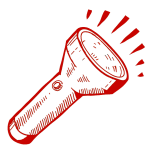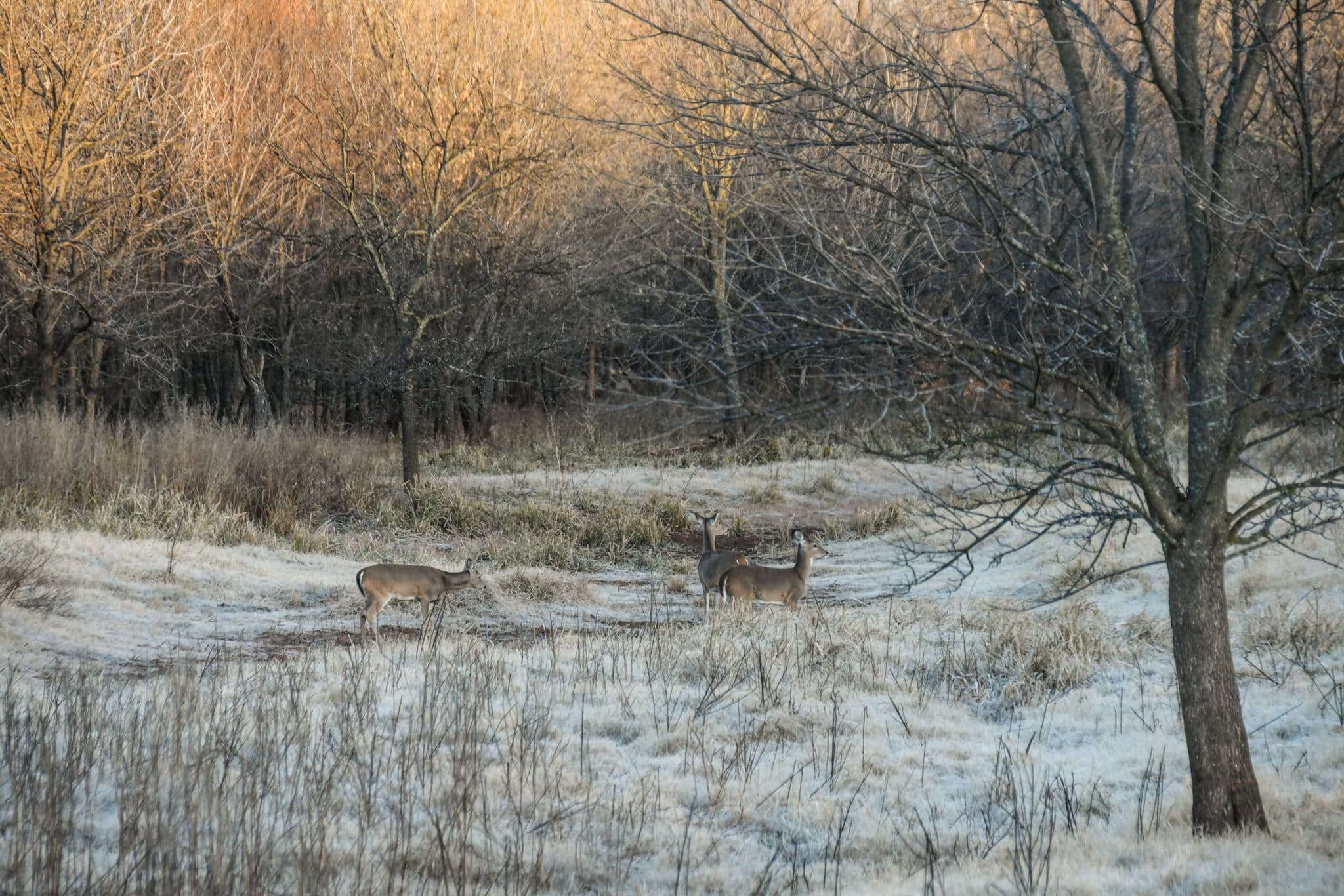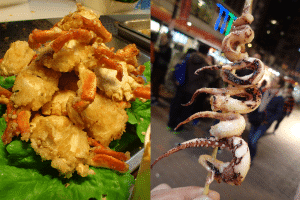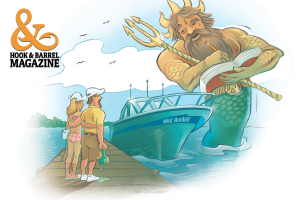- By Jim Hannaford
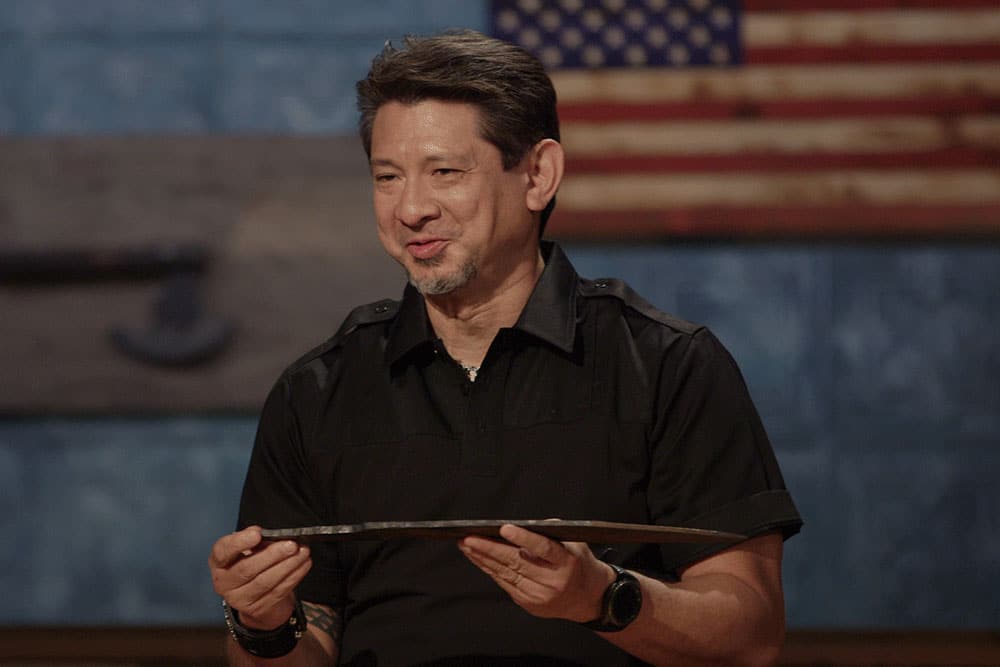
Doug Marcaida’s passion fuels Forged in Fire.
It’s safe to say that millions of people know a little bit more about knives because of the television show Forged in Fire. You can count Doug Marcaida among them.
Marcaida was already an expert on practically all kinds of blades, or he wouldn’t have been invited to be one of the judges on what has become a wildly successful History Channel program.
Like those viewers at home, he has expanded his knowledge on the intricacies of metalworking, an ancient art that retains an air of mystery even in our modern age. He has also developed a greater appreciation for the passion and artistry that go into the complicated process of making knives. “It truly is a magical transformation,” he says, “just like alchemy was in the old days.”
On the show, skilled contestants in the fairly arcane field of bladesmithing compete to custom build a knife or sword from scratch under a tight time constraint. To make it more fun and challenging, they have to make them from unlikely materials like fish hooks, ball bearings, or parts from old lawn mowers. Under this kind of pressure, their mission is to grind, hammer, and polish a blade that looks good, is well balanced, and easily does the job it’s designed to do.
When producers of the show reached out to Doug Marcaida about joining their panel of experts, he was immediately intrigued but a bit puzzled by the premise.
“At first I thought, ‘Who’s going to watch this?’” he remembers. “But then I realized that it’s kind of similar to the shows I like to watch, which are reality competition shows like Chopped and Biker Build-Out. The difference is we have sparks and fire and everything, but underneath all of that it’s about building things with your hands—it’s about imagining something and then using your creativity and skills to make it a reality.”
Before Forged in Fire came along in 2015, Doug Marcaida was already widely known as a martial arts expert, edged weapons specialist, and knife designer. Born in the Philippines, he is a U.S. Air Force veteran who was a respiratory therapist for 20 years before he decided to follow his own passion full time. He was able to forge a successful career as a trainer and consultant for military, law enforcement, and security concerns, both domestic and abroad.
His unique skill set found a comfortable home on Forged in Fire. He is literally the ultimate judge on the show, the taskmaster who puts the newly crafted knives and swords through punishing physical tests to determine if they pass or fail.

EMBRACING THE BLADE
The often-smiling Marcaida seems completely at ease on camera as he slashes and stabs a hog carcass or a lifelike gelatin test dummy. It might be hard to believe, but there was a time when he was afraid of knives. This goes back to his days as a teenager. He was involved with a street gang, he says, and one day he unexpectedly found a foe’s blade being held menacingly against his neck during what he expected to be a fistfight.
He steered clear of knives for a few years but warmed back up to them through his practice of the martial arts. His specialty disciplines of kali, eskrima, and arnis include the use of weapons in their training. “In order to conquer it, I had to face my fear,” he says. “I started to see knives as an extension of who I was —an extension of my skills.”
A CATCHPHRASE IS BORN
As Marcaida delivers his verdict to contestants on the show, he, quite memorably, has an unusual pronunciation of the word “kill.” That’s by design.
“Overall, the sword is light, fast, and sharp,” Marcaida might offer in summary before pausing, flashing his grin, and giving his final judgment: “It will KEAL.”
He means the blade will “kill,” but he substitutes a word he made up, an acronym for “keep everyone alive.” It’s a play off of a phrase used in martial arts to express the idea that it’s not about how many people you kill, but how many you protect. “I knew that children were watching, and I did not want to use a term that glorifies violence,” he says. “It’s a more positive take on a very violent act.”

MAKING THE CUT
Doug Marcaida points out that while some view knives as weapons, most people see them as tools±something they can use to slice, chop, or pierce. This brings up a question of what qualities people should look for in them.
“What makes a good knife depends on who is going to wield it,” he says. “A chef’s knife is great for a chef, but a claymore wouldn’t do him any good.”
Generally speaking, he says, knives should be made from high-quality metals for strength and durability and to be able to maintain their edge.
An important trait that’s often overlooked, he says, is the feel of a knife. It should be comfortable to hold and be properly balanced (not too heavy, not too light) so that it’s easy to use without causing any pain or fatigue.
In some cultures, knives are a status symbol, so there are ornate versions that are studded with gemstones. Usually, however, appearance plays a more subtle role. “Aesthetics are important because nobody is going to pick up a knife in the first place if they think it’s going to cut them,” says Doug Marcaida. “Once they do pick it up, they can assess how it feels in the hand and whether it’s balanced.” If a knife looks better than it feels, it will have a simple fate: “It’s going to hang on a wall and stay there.”
Some knives are inexpensive while others cost a pretty penny. A few different factors influence the retail price, including the quality and origin of the materials used in construction and whether it’s made by hand or machine. A manufacturer’s track record plays a part, too. “What makes a blade expensive is the reputation of the maker and whether they are making blades that are in demand,” he says. “Cost in some ways is determined by market value.”
CELEBRATING THE CULTURE
At 55 years old, Doug Marcaida considers his long association with the television show a blessing and finds it hard to believe they’re about to cross the milestone of 200 episodes. Filming at the studio in Hartford, Connecticut, for Forged in Fire keeps him closer to his family in upstate New York, and it’s offered a refreshing mental adjustment, too. “It has changed my whole world,” he says frankly. “It’s very different from working for the military and teaching edged-weapon tactics, which requires a very aggressive mindset. Now it’s more about celebrating my passion and celebrating the culture of the blade.”
In a gesture that comes from his martial arts training, Doug Marcaida gives a gracious bow to the contestants on the show.
“Forging a blade is something that they put their heart and soul into, so it is something that does require respect on my part,” he says. “I am honored that something so meaningful and special has been given to me to test.”
Speaking Bladesmith
Understanding the anatomy of knife.
Fixed-Blade Knives:

(Pictured, Zac Brown’s Southern Grind Jackal Hunting Knife, perfect for the avid hunter or outdoorsman, southerngrind.com)
An inherently strong option due to the tang or the back portion of the blade that extends into the handle. These knives are rigid and always ready for action. With no moving parts, they are easy to clean and will not fail due to a buildup of gunk, hair, dirt, blood, or grit.
Spine: The back of the blade, most often unsharpened; gives the blade its strength.
Jimping: Grooves created in the spine, the choil, or handle for increased grip.
Thumb Ramp: A raised area of the spine near the handle that increases control over the blade and reduces forearm fatigue.
Choil: The unsharpened edge of a blade between the end of the handle and the beginning of the edge bevel.
Belly: The curved arc as the sharpened edge nears the knife tip—intended for cutting.
Folding-Blade Knives:

(Pictured, Zero Tolerance Model 0230, minimalist folder designed by Danish designer Jens Ansø, zt.kaiusa.com)
Generally smaller and easier to carry than fixed-blade knives. Common with pocket clips and locking mechanisms, these knives are hugely popular for everyday carry. Many are designed to open with one hand through a thumb stud or even an auto-opening device (Illegal in some states).
Ricasso: The shank of the blade between the handle and the beginning of the sharpened edge.
Nail Mark, Thumb Hole, or Stud: An addition to the spine of the blade that assists a user in opening the knife.
Grind: The finish of the shape of the blade when viewed in cross section. Hollow-grind knives have a concave shape and are easy to sharpen. Flat-grind knives taper evenly and hold an edge well.
A Cut Above the Rest

Three of our favorite knives.
Combat & Self-Defense:
Doug Macaida Fixed Talon, 511tactical.com
If fixed-blade karambits (knives shaped like a talon) are your style, accept nothing less than one designed by Forged in Fire host Doug Macaida. The D2 blade’s curved design is small but precise and can act as a hook for takedowns. With a compact overall length, Kydex sheath, and ring that makes a perfect impact weapon, it’s ideal to tuck into your waistband and carry as your primary blade or as a backup weapon. This knife is well suited for self-defense and martial artists.
Survival & Bushcraft:
Benchmade 202 Leuku, benchmade.com
There’s no sense in beating around the bush when you can cut right through it. Enter the woods with peace of mind and the 202 Leuku on your hip. This no-nonsense fixed blade is built for strenuous bushcrafting applications while maximizing in-hand comfort. With Finnish/Nordic roots, this knife has a strong history of brush clearing to food prep stemming all the way back to reindeer herders on the tundra.
Everyday Carry:
Kershaw Launch 13, kershaw.kaiusa.com
This snakebite fast, auto-flipper combines the best of both slimness and full-sized cutting ability. Its Wharncliffe blade is perfect for fine work, yet it’s slightly angled for more versatile cutting. The narrow profile and deep-carry pocketclip let this folding knife easily ride in your pocket. Design details round out the package, including an integrated lanyard hole, a two-tone blade, and a custom triangular pivot.

